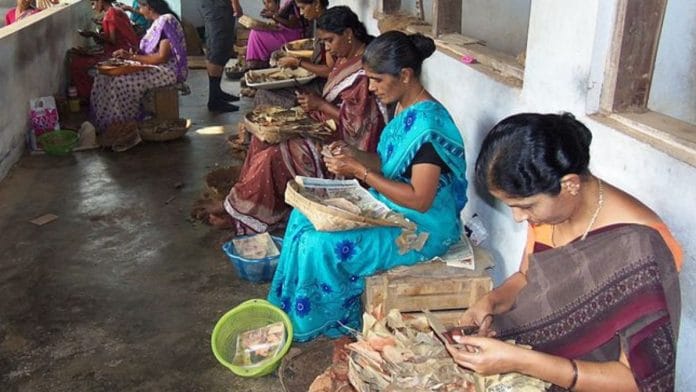Rome: Women constitute 43 percent of the workforce in India’s unorganised manufacturing sector but are engaged in low-quality, low-paid work.
Moreover, for every 1,000 unorganised enterprises in India, there are 947 proprietary set-ups — 718 led by men and 229 by women — which translates to women-led proprietorships accounting for only a quarter of such establishments in India.
The Annual Survey on Unincorporated Sector Enterprises (ASUSE) 2022-23 — published by the Ministry of Statistics and Programme Implementation (MoSPI) last month — has revealed this bleak reality of women workers in India’s informal work landscape.
However, a deeper look at the data paints a more favourable picture, with patterns of leadership by women emerging across the manufacturing, trade and other services sectors.
Nearly 55 percent of India’s unincorporated manufacturing enterprises are led by women, the ASUSE data has shown. This percentage is significantly higher than in trade, where women lead 12.4 percent of the enterprises, followed by women leading 11.1 percent of the other services enterprises.
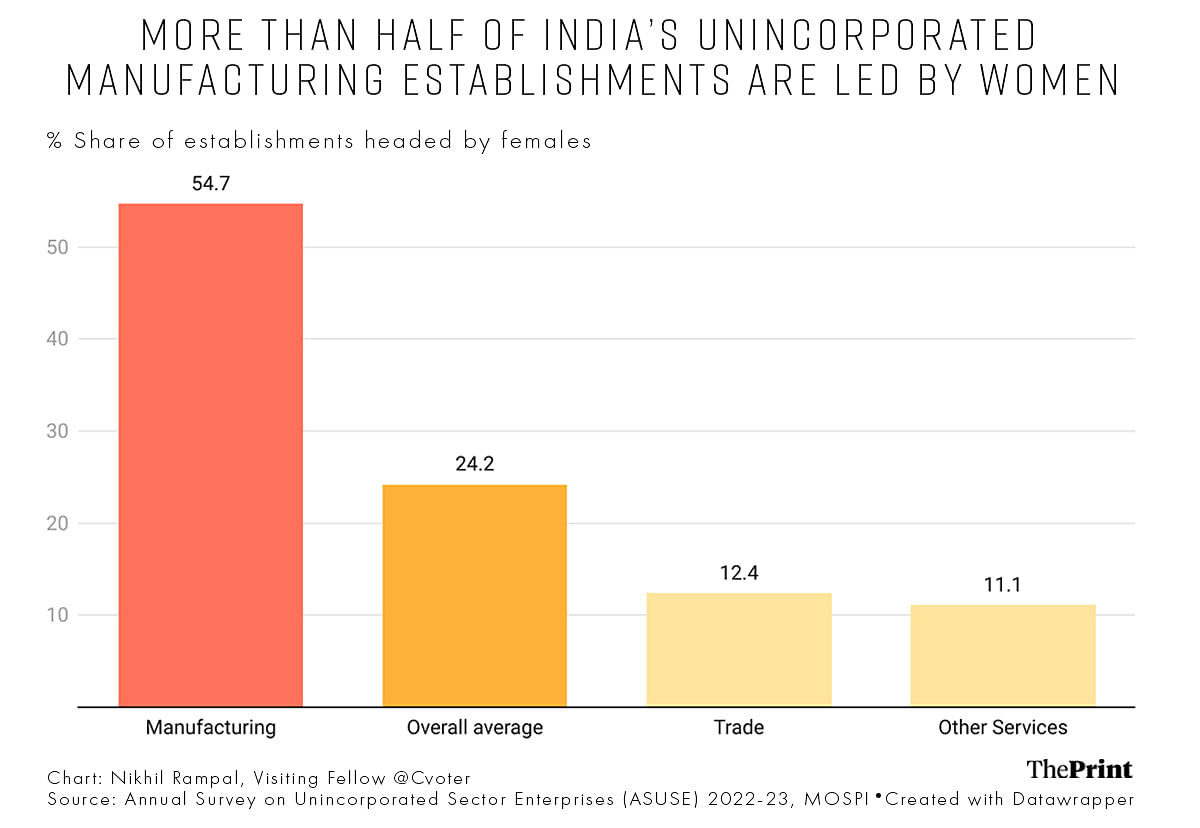
State-wise data has shown that in southern parts of the country, one is more likely to find women-led manufacturing proprietorships, with Telangana topping the charts. In Telangana, nearly 78.56 percent of the manufacturing enterprises in the unorganised sector are women-led. This percentage is 64.03 percent in Karnataka and 59.61 percent in Kerala.
In Andhra Pradesh, 53.81 percent of the manufacturing enterprises in the unorganised sector are women-led. More than 50 percent of the enterprises in the unorganised manufacturing sector of Tamil Nadu are women-led as well. However, these figures are below the national average of 54 percent.
Delhi reported the lowest share of women-led enterprises — 19 percent — followed by Uttarakhand (25.56 percent), Assam (36.62 percent), Chhattisgarh (40.41 percent), Rajasthan (42.87 percent), Bihar (45.2 percent), Haryana (45.31 percent), and Punjab (46.11 percent).
Also read: Tamil Nadu assembly passes Bill allowing 12-hour work days, DMK allies, Opposition walk out
Women to men ratio highest in manufacturing
The unorganised sector provides jobs to roughly 10.98 crore workers, but only 25 percent are women, with the majority involved in trade (35.6 percent) and other services (36.5 percent). However, compared to men, women form a low proportion of the workforce — 17 percent in trade and 20 percent in other services.
While only 27.94 percent of the total women workers are in the unorganised manufacturing sector, they account for 43 percent of the sector’s workforce. The percentage of women workers to total workers in the unorganised manufacturing sector is roughly 18 percentage points higher than the 25 percent national average in the whole of the unorganised sector.
At the establishment level, only 30 percent of the unorganised workers who are themselves an entity, referred to as ‘Own Account Establishments (OAEs)’, are women. In the manufacturing sector, roughly 60 percent of OAEs are women; in the trade sector, roughly 22 percent are; and in other services, nearly 16 percent are.
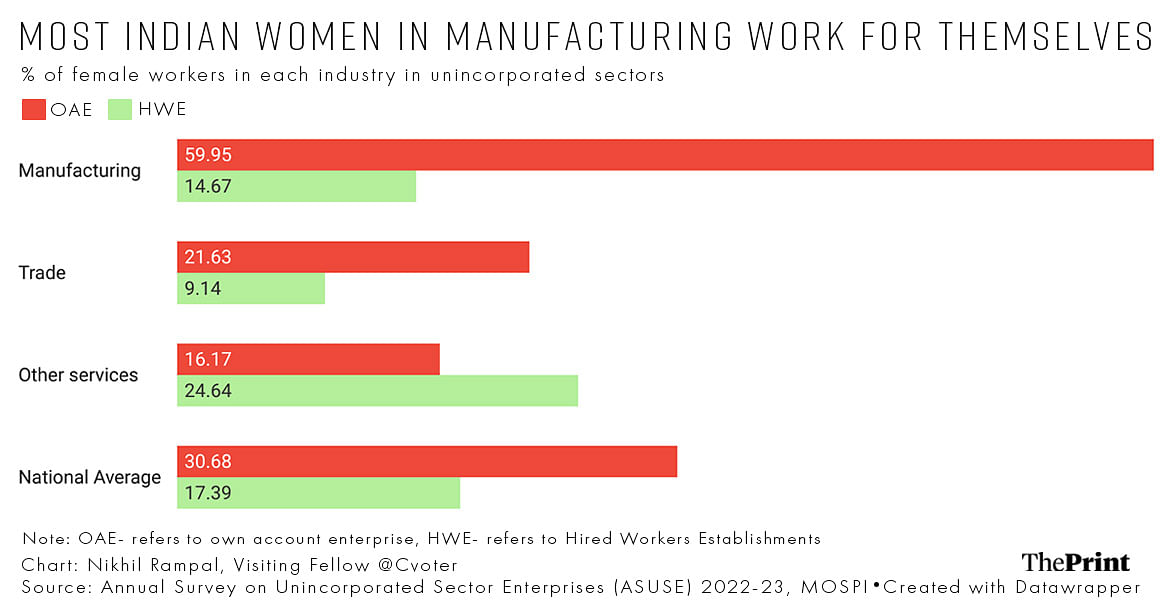
Another highlight is that women’s representation falls drastically in the ‘Hired Worker Establishments (HWEs)’, reinforcing that while women seem more inclined towards entrepreneurship, they do not get hired that much. HWEs employ at least one additional worker on a fairly regular basis.
According to the data, only 17.39 percent of the workers in HWEs are women. In the manufacturing sector’s HWEs, only 14.67 percent of the workers are women. Similarly, women constitute roughly 9 percent and 25 percent of the workers in the trade and other services HWEs.
Also read: Unorganised, non-farm sector employs 19% of workforce but accounts for 6% of GDP, shows MoSPI data
Low-quality, low-pay jobs
The ratio of women to men workers in the unorganised manufacturing sector is better than in other sectors because of their preference in the job categories concerned.
The ASUSE Survey has noted that 82 percent of all the women employed in the unorganised manufacturing sector are in tobacco manufacturing (mostly bidis), textile manufacturing, and the manufacture of apparel.
While 93 percent of the workers in tobacco products manufacturing are women, 76 percent of workers in apparel manufacturing are women, and 67.2 percent in textile manufacturing are.
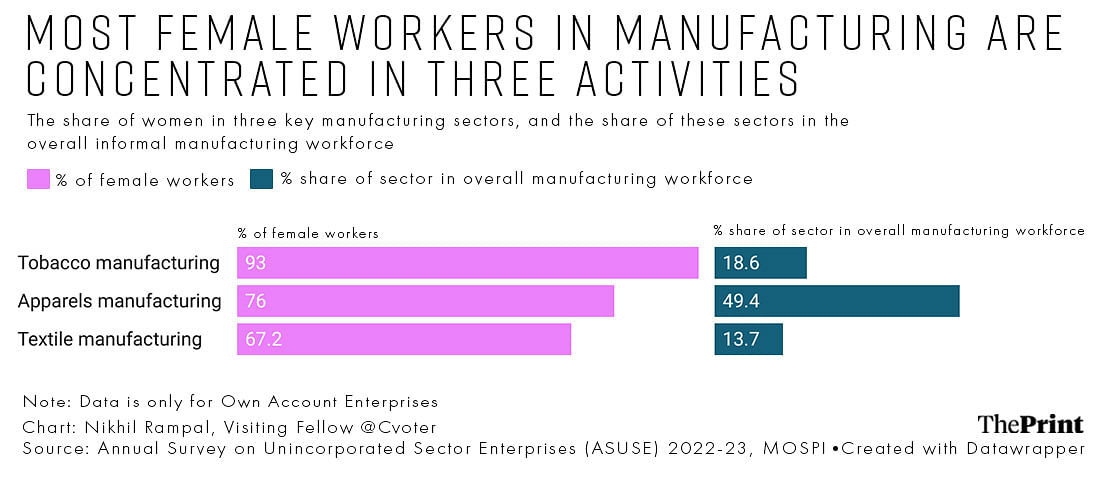
However, the value addition or the output value of the goods produced by the women-led OAEs is low, with the women workers not getting paid much for their work.
The gross value added (GVA) per worker in the unorganised manufacturing sector OAEs is roughly Rs 75,000 a year or a little over Rs 6,000 a month on average.
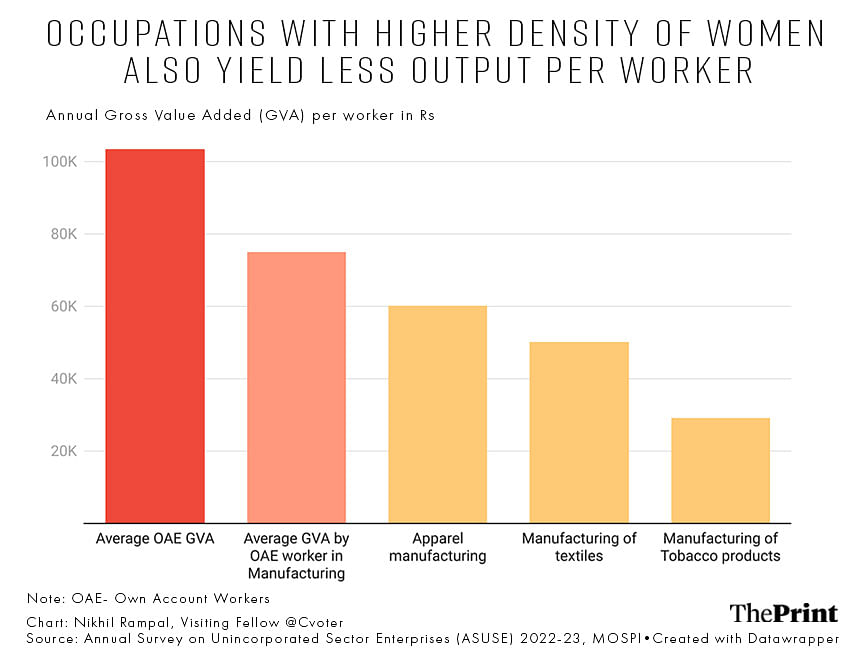
In the tobacco and beedi-making industry, where 93 percent of the workers are women, the average GVA per worker is Rs 29,000 — less than Rs 2,500/month and less than half the national average.
In the clothing apparel category, the GVA per worker is below the national average, too — roughly Rs 60,000 per year or Rs 5,000 a month — while it is Rs 50,000 per year in the textile manufacturing industry.
Nikhil Rampal is a visiting fellow at the CVoter Research Foundation. You can reach him on X (formerly Twitter) at @NikhilRampal1
(Edited by Madhurita Goswami)
Also read: Despite highest wages across India, Kerala’s young males are among most unemployed in the country



